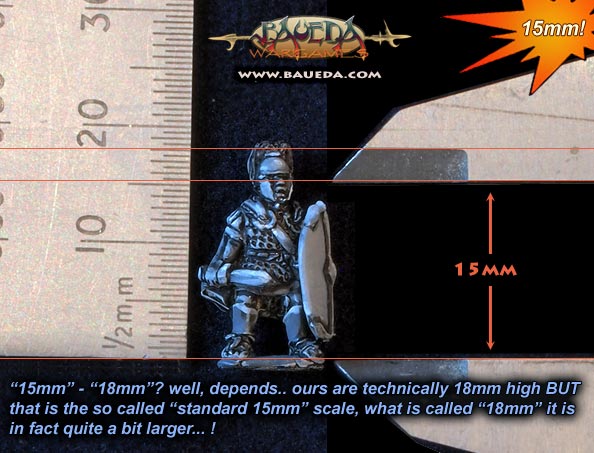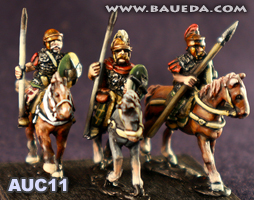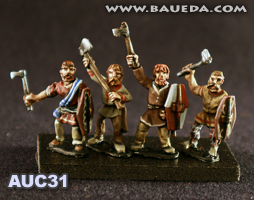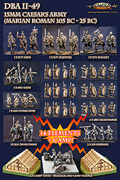

| 15mm Caesar’s army (Marian Roman) | AVAILABLE NOW! |

|
||
|
Alea iacta est!
What size are these? 
Historical Accuracy: painstakingly researched all our figures accurately reproduce the historic subject according to the very latest research and archeological evidence. Quality: all our figures are exquisitely sculpted by the very talented Marco Campagna (who also made most of our other figures) or by myself. All are full of deeply carved or raised details to ensure the best possible result with the minimum painting effort. We use a very high quality lead free pewter alloy that is extremely tough and resilient, much harder than the soft lead based alloys you may be familiar with... it doesn't bend as easily and it won't break even if bent and straightened back for many, many times! Variety and Subjects: there are 4 different poses for all foot and 3 different poses for all mounted packs (unless specified otherwise), and all these poses are entirely different, not just small variations of the same figure! All packs are designed to fit a specific troop type as recognized by all major rule systems. Convenience and Format: all our figures are available in small inexpensive packs so you can get only what you really need. All figures are cast in one piece with only the horses being separate: no fiddley bits to attach! All figures come in packs of 8 foot or 4 mounted unless otherwise specified. This range has been sculpted by M. Campagna and C. Berni and it currently cover all core and most auxiliary troops, but we plan to expand it even further... eventually we hope to cover every aspect of the subject, including baggage train with pack mules and handlers, praetorian guard, siege troops and equipment, legionaries in winter clothing, casualties, armed slaves, herders and bandits for servile wars, testudo and more! Appropriate horses are provided at random out of nearly a dozen different poses to maximize variation! Shield transfers from LBMS specifically made for this range are available in six different styles! 
 



Wondering how the Roman Republican army changed after the Marian reforms? Watch this video! |
|
 Figures sculpted by M. Campagna Painted samples by Knight Brush Studio |
|
 Figures sculpted by M. Campagna Painted samples by Knight Brush Studio |
|
 Figures sculpted by M. Campagna and C. Berni Painted samples by Knight Brush Studio |
|

|
|

|
|
 |
|

|
|

|
|

|
Click for a larger picture!
|
|

This is a model kit of a Roman Marching Camp set based on our "HOPPIDUS" modular system for ancient fortifications and designed specifically to be used with DBA rules. This set contains a selection of all the modules you need to recreate this temporary fortification, such as those made by the army every evening when camping. The complete set as shown above consist of a base formed by two corner sections of low embankment elements, which leave a full module frontage (40mm) gap, four sections of sudes stakes and a trunk with spikes to close the gap itself. Two supports are also supplied to hold the spiked trunk. Sudes is Latin for stake or pike. They were part of the standard Imperial legionary equipment and presumably used as a perimeter defense of an encampment. Also termed valles, they were wooden stakes 4 to 5 feet long, tapered to points at both ends with a cut out "handgrip" in the middle. They may also have been used to create a palisade or picket defense in front of a position prior to an enemy's expected charge or attack. These stakes are often incorrectly termed Pila Muralis or "Wall Spear" which instead probably was a particularly heavy javelin made for throwing down from walls. Experiments that show them to be easily pulled out if used as a fence are all done by driving them into a finished rampart, but more likely they were inserted into the rampart as it was built and the soil packed around them, so that half their length was buried. This way they would still reach up beyond the bottom edge of a defender's shield, and be much harder for an attacker to pull out; we've therefore chosen to represent them in this way. All the products in the fortifications range are supplied unpainted in kit and require assembly. This kit include all the modules required to make a legal 120x40mm DBA camp large enough to hold an element of camp followers in the courtyard. It includes 9 parts, basic assembly instructions, guidelines and painting examples. Please note that the kit does not include (but does need) a base like that shown in the picture. You can make one yourself easily enough, so we didn't felt it was the case to charge you for a rectangular piece of cardboard! HOPPIDUS is a truly modular system, and all elements of this set are compatible with the rest of the range. This means you can also add more elements from the complete HOPPIDUS range to expand and customize this basic set, for example adding the other three sides on a separate base, to make a completely enclosed fortified perimeter that can be used for a scenario game or as a Build Up Area... Just remember you can pick and choose any combination of modules you like, and we're here to help you at any time, so just e-mail us for any special requirements! Click here for shipping charges Finished camps painted and ready to play: available on commission order; contact us for details! |




|
| |
|
|
|
Want this model pre-painted, based and Ready-to-Play? Click here!   Want this model pre-painted, based and Ready-to-Play? Click here!
Want this model pre-painted, based and Ready-to-Play? Click here!
|
|
Want this model pre-painted, based and Ready-to-Play? Click here!  Want this model pre-painted, based and Ready-to-Play? Click here! |
|